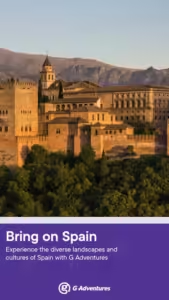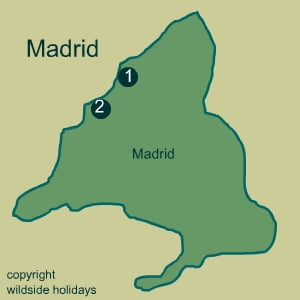Walking and wildlife holidays in Madrid
- Capital: Madrid.
- Area: 8,030 km²

We may think of Madrid as the capital city of Spain, therefore low on the list for nature enthusiasts but Madrid province, that surrounds the city, will surprise you with its variety.
Birds observed include Black vulture, Imperial eagle, Red kite, Great bustard, Little bustard, White-headed duck, Rock sparrow and Spanish sparrow.
These species reside in the different habitats on offer such as lagoons, plains and mountains.
Red deer, Fallow deer, Roe deer, Fox, Wild cat, Mountain goat and Wild boar all enjoy the mountains to the north west of the region.

The Guadarrama mountains, part of the Sistema Central range, create a natural border in the north west. (Joining with Sierra de Gredos in the province of Castilla y Leon)
Find a hotel in the Guadarrama mountains here.
The highest peak here is Peñalara at 2430m. Given this altitude and the Mediterranean influence, it is easy to see why the temperature extremes for Madrid are from 0ºc to 40ºc.
This huge fluctuation in temperatures in turn allows for a wealth of variation in the animal and plant kingdoms. Holms oak, Juniper, Ash, Willow and Scots pines flourish with shrubs such as Lavender, Rockroses, Thyme and Brooms.
Tours in Madrid from Viator
Madrid has a vast array of sites to visit and enjoy. Below are some of the options listed on the Viator website. (We recieve a small commission if you book a tour which doesn’t cost you more and helps us to keep Wildside Holidays up to date with the best information.)
If you are staying in Madrid there are also day trips available to natural parks and other protected areas.
Natural Parks in Madrid

A more harsh section of granite massif within the Guadarrama range is called La Pedriza. This is a magnet for rock climbers to test their skills on the strangely eroded, complex formations which are unique in the world.
This area is also the source of the river Manzanares which runs through Madrid city.
The Manzanares joins with the Tajo river which forms the southern border of the province.
The meseta, or high plateau upon which Madrid sits at around 650m above sea level.
National Parks in Madrid
1 Guadarrama National Park Not without it’s controversy over the years (due to it conflicting with housing and other human development plans), the Guadarrama National Park project was finally declared in 2013. Its aims are to protect the eleven different ecosystems present in the Guadarrama mountains, including the only Iberian examples of “high Mediterranean mountain”.
Some great options for hotels and country houses in the Sierra de Guadarrama here.
There are almost 1,300 different animal species in the area of which 13 are in danger of extinction. The species of animals in the mountains represent 45% of the total fauna of Spain and 18% of European fauna. There are mammals such as deer (red, roe and fallow), wild boar, Spanish Ibex, badgers, several mustelidaes, wild cats, foxes, hares, etc. Iberian wolf also seems to have returned to the area after a 70-year absence..
2 Peñalara, Cumbre Circo y Lagunas Natural Park Since the early 2000s, the government of the Community of Madrid and that of Castilla y León carried out a project to declare a large part of the Sierra as a National Park and after the declaration of the Sierra de Guadarrama National park, the Peñalara Natural Park, Cirque and Lakes Nature Reserve (Parque Natural de la Cumbre, Circo y Lagunas de Peñalara) now comes under the control of and is inside the limits of the Guadarrama National Park.
John Muddeman Wildlife Tours
Tailor-made Wildlife Tours in Spain
Travellers often want a birdwatching or wildlife tour orientated specifically to suit their needs. John can offer you tours in Spain personally designed to suit your needs, be the emphasis on birds, botany, mammals, butterflies or dragonflies.
Regional Parks in Madrid
The South East Regional Park (Parque regional del Sureste) is an area of Madrid that extends from north to south along the Jarama river and presents a great variety of habitats some of which are considered the best and well preserved wetlands in the Comunity of Madrid such as the Mar de Ontígola close to the town of Aranjuez, Laguna de San Juan near Chinchón and the gravel pits between the rivers Jarama, Manzanares and Henares (Soto de las Juntas and El Campillo).
The Cuenca Alta del Manzanares Regional Park (Parque Regional de la Cuenca Alta del Manzanares) is one the largest protected natural areas in the Community of Madrid and now comes under the protection of the Guadarrama National Park.
The Regional Park of the Guadarrama River (Curso Medio del Río Guadarrama y su Entorno) protects approximately 38% of the course of the Guadarrama, whose total length is 131.8 km. The demographic and human population pressure, derived from the existence of numerous large towns in the vicinity (some on the very edge of the river) constitutes the main threat to this protected natural space and almost 90 percent of this regional park is privately owned.
Other protected areas in Madrid
The hayedo Montejo beech forest is located on the slopes of the Sierra de Ayllón and is protected as a Natural Site of National Interest. It is a site of Community Importance (SCI) of Alto Lozoya and is also included within the limits of the the Sierra del Rincón Biosphere Reserve.
The Fauna Refuge of San Juan Lagoon (Refugio de fauna de la Laguna de San Juan) covers an area of 40 hectares and is found along the lower course of the River Tajuña. It is an important wetland area close to the town of Chinchón and one of the largest bird reserves in the Community of Madrid.
The Natural Reserve of El Regajal-Mar de Ontígola is one of the most unknown natural spaces in the Community of Madrid, despite having a great wealth of fauna . This is due to the fact that most of its 630 hectares are on private farms. (The one of El Regajal stands out, which has its own vineyards and winery attached to the designation of origin of Vinos de Madrid.)
Wildlife and Nature in Madrid Province: FAQs for Nature-Based Travel
Despite being home to Spain’s capital, Madrid Province offers impressive biodiversity across its plains, wetlands, and mountains. Birdwatchers can observe raptors such as the Black Vulture and Spanish Imperial Eagle, along with the Great Bustard, Little Bustard, White-headed Duck, Rock Sparrow, and Spanish Sparrow. These species thrive in habitats ranging from steppe to high-altitude wetlands. In the mountains to the northwest, mammals like Red Deer, Roe Deer, Fallow Deer, Foxes, Wild Cats, Mountain Goats, and Wild Boar are commonly found. Notably, the Iberian Wolf has returned to the Guadarrama range after a 70-year absence, indicating improving ecosystem health.
Madrid Province’s geography directly shapes its ecological diversity. The Guadarrama Mountains, part of the Sistema Central, rise in the northwest and peak at 2,430 meters at Peñalara. These elevations, combined with a continental-Mediterranean climate, create temperature swings between 0°C and 40°C. These shifts encourage a variety of plant and animal adaptations. The province also includes the central Meseta, a high plateau at 650 meters, and is crossed by rivers like the Manzanares and the Tajo, which provide key aquatic habitats. These features create a mosaic of environments that sustain both temperate and Mediterranean flora and fauna.
Madrid is home to a range of protected natural spaces designed to conserve its ecological wealth. The largest is Guadarrama National Park, declared in 2013 to protect eleven ecosystems, including rare high Mediterranean mountain environments. Nearly 1,300 species live here—13 of which are endangered—representing 45% of Spain’s total fauna. The Peñalara Natural Park, now part of this national park, features glacial lakes and alpine landscapes.
Other major conservation zones include:
The South East Regional Park, known for Jarama river wetlands like Laguna de San Juan and Mar de Ontígola.
Cuenca Alta del Manzanares, Madrid’s oldest protected area, now managed within the national park.
Guadarrama River Regional Park, safeguarding the river’s mid-course, despite nearby urban pressures.
Montejo Beech Forest, a UNESCO Biosphere Reserve within the Sierra del Rincón.
San Juan Lagoon Fauna Refuge, a key bird reserve along the River Tajuña.
El Regajal–Mar de Ontígola Nature Reserve, rich in fauna but mostly privately owned.
These areas protect vital habitats, from ancient forests to semi-arid lagoons, across the province.
Madrid’s mix of mountain, plateau, and wetland environments supports diverse vegetation. Tree species include Holm Oak, Juniper, Scots Pine, Ash, and Willow, which grow according to altitude and moisture levels. Shrubs like Lavender, Thyme, Rockrose, and Broom blanket the lower slopes and dry zones. In high-altitude areas like those in the Guadarrama National Park, rare Mediterranean alpine species thrive—many of which are endemic to central Spain and form part of one of Europe’s most unique montane ecosystems.
Madrid offers excellent opportunities for wildlife tourism, especially for birdwatching and hiking. Walking and wildlife holidays are promoted by Wildside Holidays, who spotlight Madrid’s lesser-known natural wonders. Expert-led trips—like those offered by wildlife guide John Muddeman—can be tailored to focus on birds, mammals, butterflies, dragonflies, or botany. Options include private tours, cultural walks, and even hot air balloon rides. Platforms like Viator also list eco-friendly experiences that explore natural parks, mountain trails, and regional reserves.
La Pedriza, located within the Guadarrama range, is one of Madrid’s most iconic natural formations. Its weathered granite landscape—marked by sharp ridges, bizarre boulders, and natural sculptures—attracts climbers from across Europe. But it’s not just for adventurers. La Pedriza is ecologically important as the source of the Manzanares River, which flows through Madrid and eventually joins the Tajo. Its rugged terrain also provides habitat for mountain goats, raptors, and hardy alpine plants, making it a top destination for hikers and wildlife watchers alike.
About the author of this article.
I’ve been living in this lovely area of Western Andalucia for the last 20 years or so and dedicate most of my time to the running of English language tourist information websites for the towns of Cádiz, Ronda, Grazalema, the famous or infamous Caminito del Rey, and also Wildside Holidays, which promotes sustainable and eco-friendly businesses running wildlife and walking holidays in Spain.

